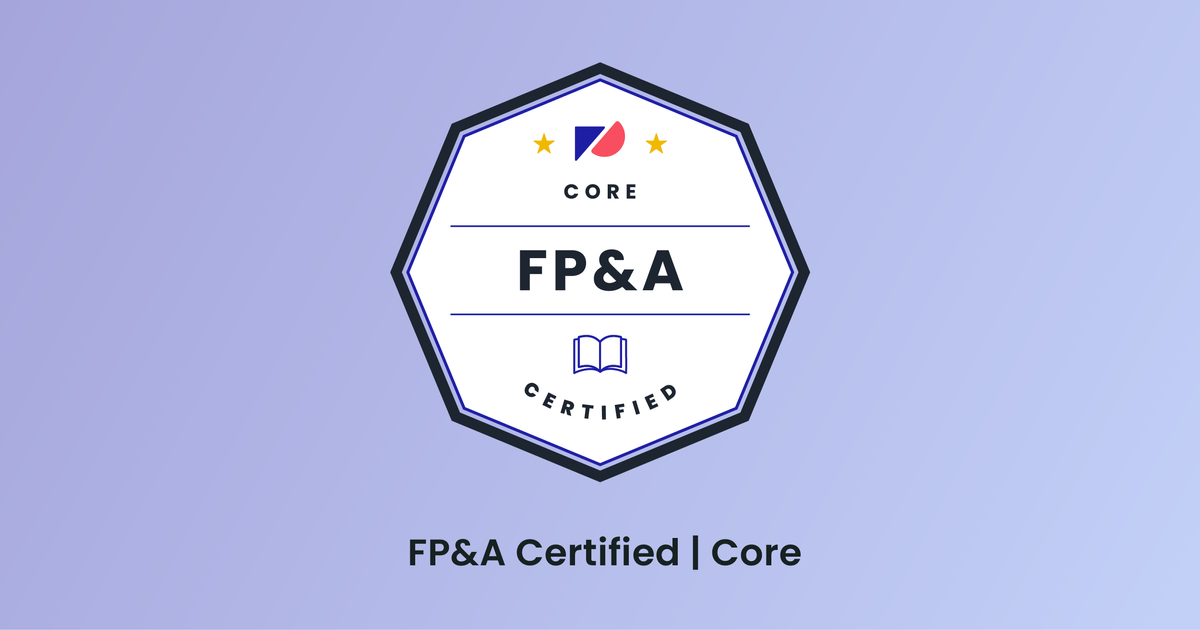[This article is based on a presentation given by Vaughn Grandin, James Manning, previous Director of FP&A at York IE at our FP&A Summit, Boston in 2023. Catch up with this presentation, and others, using our OnDemand service. For more exclusive content, visit your membership dashboard.]
Have you ever made a mistake in your forecasting or budgeting process?
You're not alone. Mistakes happen to the best of us, but instead of dwelling on them, these errors can be turned into opportunities for growth. By learning from them, you can strengthen both your own skills and your FP&A function.
In this article, we'll explore key lessons in implementation processes and corporate strategy, and how you can use them to achieve real, tangible results in your FP&A function. You'll also discover real-world examples and success stories to inspire and guide your own journey to success.
Topics covered:
- The role of FP&A in corporate strategy
- What is the corporate strategy?
- Implementing FP&A
- Areas covered in outsourced FP&A process
- Why FP&A is necessary
- Case Studies: Lessons from the field
- Takeaways
- The future of FP&A
The role of FP&A in corporate strategy
Now, let’s dive into the role of FP&A within a corporate strategy. One of the themes we consistently emphasize with our clients and portfolio companies is the importance of moving beyond just numbers. FP&A should drive toward specific, tangible goals that align with the company’s overall strategy.
Often, when we ask companies about their corporate strategy, the responses are vague things like mission statements or large market opportunities. While that’s a good starting point, the real work begins when we break down how to achieve those goals.
FP&A plays a critical role in identifying key milestones, pivot points, and ensuring that the organization is structured in a way that holds people accountable for achieving those milestones.
Even in small, early-stage companies, silos can quickly develop, and the workload often overwhelms teams. This is why a strong FP&A function needs to be implemented as soon as there’s data to analyze and actions to take.
FP&A should act as a hub, synthesizing information from various parts of the organization and feeding it back to the right stakeholders to ensure everyone understands how their role contributes to the company’s success.
What is the corporate strategy?
The corporate strategy is the long-term plan of action designed to achieve the goals and objectives of a company. A strong corporate strategy should be aligned with the company’s core competencies, or its unique strengths and capabilities that give it a competitive advantage in the marketplace.
A comprehensive corporate strategy will also consider capital requirements a company needs to realize its goals.

Implementing FP&A
When it comes to implementing an FP&A function, the first step is aligning it with the company’s corporate strategy. This often involves cleaning up historical data - an area where companies that delay FP&A implementation face more challenges.
From there, we conduct baseline analysis to see how far the company is from its stated goals and whether those goals are realistic given the current data.
Once this groundwork is done, we can launch the initial forecast and begin the regular FP&A workflow, which includes variance reporting, error testing, and re-baselining.
A lot of this early work focuses on cleaning up processes, implementing the right systems, and creating a continuous flow that helps the organization adapt and grow.
Here are the steps of a typical FP&A implementation process:
1. Define corporate strategy and organizational goals
2. Historical data clean-up/assumptions gathering
3. Initial/baseline analysis
4. Verify goals and timelines of corporate strategy
5. Launch initial forecast
6. Conduct initial variance reporting
7. Error testing/root cause analysis (RCA)
8. Re-forecasting and continuous improvement
Areas covered in outsourced FP&A process
Many early-stage companies, especially those without robust systems in place, struggle to organize and analyze their data. We help these companies compile their data into an actionable format, perform trend and KPI analysis, and ultimately support better decision-making.
It’s important to note that even mature companies sometimes struggle to utilize KPIs effectively. It’s not enough to say, “We lowered this expense, so our KPI improved.”
What’s more important is understanding the broader context—what those numbers mean in a dynamic environment and how they affect the company’s long-term goals.
Here's a breakdown of the areas covered in outsourced FP&A processes:
- Financial planning: Developing long-term financial plans and forecasts based on a company’s goals and resources.
- Budgeting: Assisting in the creation of an annual budget and regular monitoring actual results against budget.
- Cost management: Analyzing and recommending ways to reduce costs, improve efficiency, and increase profitability.
- Risk assessment: Identifying and evaluating financial risks, and recommending strategies to mitigate them.
- Data extracting, transforming and loading: Compiling existing internal and external datasets that will inform the planning and analysis process.
- Financial reporting: Providing regular financial reports that summarize the company’s financial position and performance, including income statements, balance sheets, and cash flow statements.
- Performance analysis: Analyzing past and current financial performance to identify trends, strengths, and weaknesses.
- Decision support: Providing financial analysis and recommendations to support strategic and operational decision making.

Why FP&A is necessary
Even in small organizations, the need for FP&A is clear. Traditional organizational structures - where information flows top-down - can be slow and inefficient, especially in fast-paced industries.
FP&A helps streamline communication, ensuring that critical information is available to all stakeholders in real-time. This prevents delays and miscommunications that can seriously hinder a company’s progress.
Without a mechanism in place to centralize, analyze, and disseminate key business data, the organization risks isolating its different functions and losing access to critical information that should be used to inform business strategy.
Case Studies: Lessons from the field
Let’s move on to some case studies that illustrate the value of FP&A in different contexts.
The growth-stage SaaS company
One of our portfolio companies, a B2B2C SaaS business, was growing rapidly but struggling to secure funding due to mixed messaging. They had the right metrics, but they were tailoring their story differently for each potential investor. We helped them refine their narrative and focus on the key KPIs that truly mattered, leading to a successful raise and a more efficient operating structure.
The mature pe-owned business
Another client, an older company owned by a PE firm, was experiencing flat sales and product misalignment. Despite having excellent data, the company’s leadership had unrealistic expectations about future funding. We helped them refocus on internal improvements and identify customer segments that were still performing well. This led to a more aligned product roadmap and operational success, though not without some necessary cuts.
The consumer product company
A consumer product company we worked with had recently added a subscription service to complement their physical products. This was essentially a whole new revenue model, and they needed help navigating the complexities of managing both models simultaneously. We guided them through the process of managing their cash flow and prioritizing high-margin opportunities, which ultimately set them up for long-term success.
Key takeaways
From these case studies, several common lessons emerge:
1. FP&A needs clear goals and accountability
Without defined corporate goals, FP&A can feel hollow. It’s crucial to segment accountability and measure progress toward specific objectives.
2. All investments must have an expected return
Every expense is an investment with an expected return. FP&A must hold the organization accountable for tracking those returns.
3. Measure what matters
Even if something seems difficult to quantify, it’s important to create parameters and measure progress.
4. Signal vs. noise
The longer you delay measuring important metrics, the harder it is to clean up the data later. Without measurement, initial biases can cloud decision-making.
Finally, it’s essential to meet organizations where they are. Whether you’re working with entrepreneurs or internal stakeholders, it’s important to pace change and ensure everyone is aligned with the goals and processes that will drive long-term success.
The future of FP&A
As FP&A leaders, our role is expanding. The finance function is increasingly positioned at the center of organizational strategy, and it’s critical that we embrace this responsibility. By fostering intellectual curiosity and going deeper into the goals of different departments, we can become true leaders in driving the company’s success.
While FP&A may not always get the spotlight like a big sales win or new product launch, its impact compounds over time. Building coalitions, driving accountability, and contextualizing decisions are key to ensuring the long-term success of any organization.
P.S. Don't forget, as a Pro or Pro+ Member, you can watch James' full speaking session On-Demand right here.




 Follow us on LinkedIn
Follow us on LinkedIn




